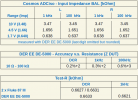Here you go. Note that I have a 4Vrms signal referenced against dBV here so the vertical offset is different from Amir's. I think this is with no averaging.
The upper harmonics and "grass" change a bit at different sample rates. Mostly the 2nd, 3rd, and 5th stay consistent.
Thank you so much for the follow up.
Signal levels are comparable (-1.5dBFS for Cosmos ADC, -1.9dB for APx555). I see about -130dBc for the AP and about -134dBc for the Cosmos, eyeballing the highest component. Cosmos has very low harmonics with the 3rd dominating, APx has dominating 5th (unless that's a spurious needle) and more equal levels for the other harmonics.
Noise (-117 vs -116dB) is also very comparable (and this is a B-grade unit, and not in mono mode for the R-channel). SINAD is very comparable, therefore.
Cosmos in B-grade is definitely on par with the AP in this comparison and Ivan has done an excellent job (the low HD2 and HD3 tell his distortion compensation calibration of each individual unit is dialed in pretty well, and maybe it could even be bettered with an APx in HPSA mode as the monitor).
In HPSA mode, APx obviously improves both in distortion as in noise floor... we would have to compare that with the APU(notch) + Scaler(Autoranger) + Cosmos(ADC) combo.
But a standalone 0-Grade Cosmos in Mono (or inverted Mono) mode and with compensation dialed in with an APx would really come close already or a bit better wrt noise floor.
















